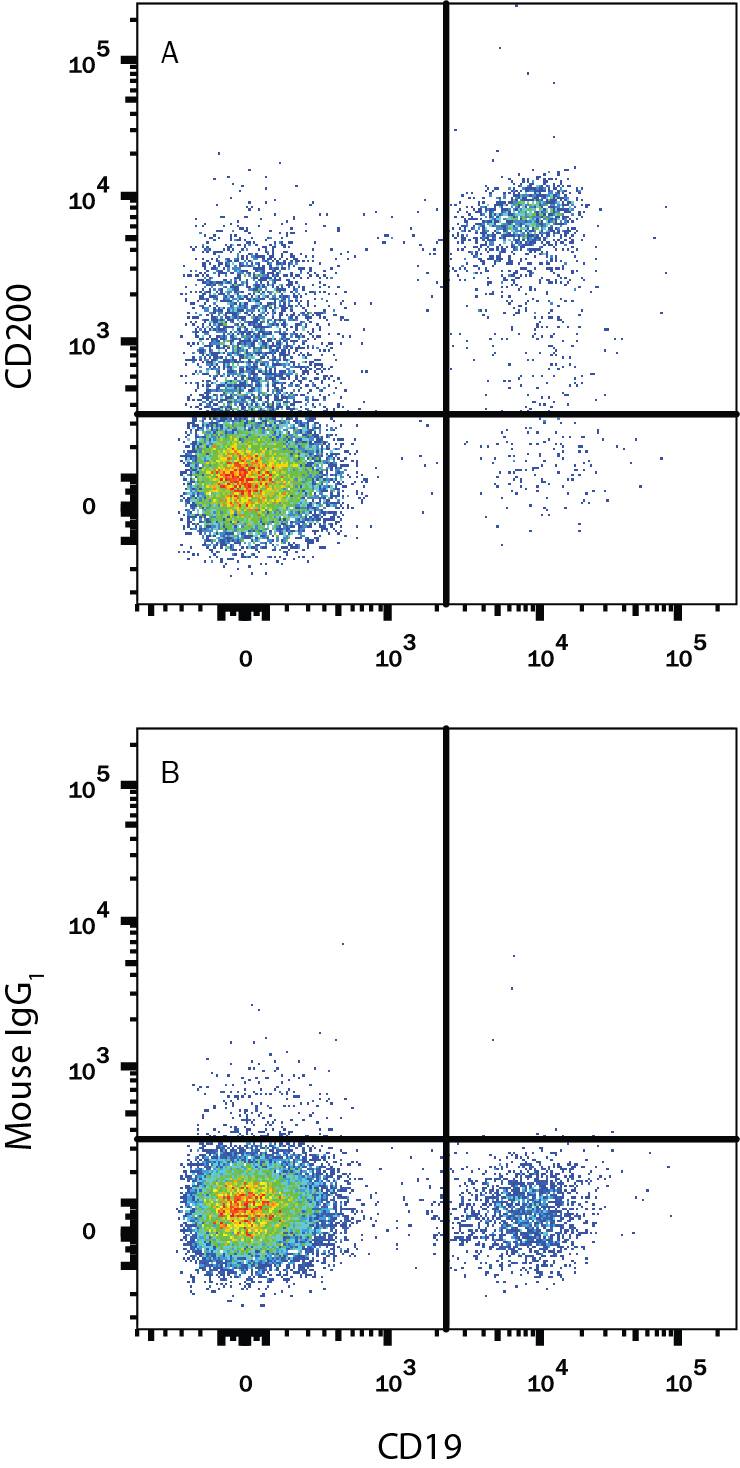Human CD200 PE-conjugated Antibody
R&D Systems, part of Bio-Techne | Catalog # FAB27241P


Key Product Details
Species Reactivity
Validated:
Cited:
Applications
Validated:
Cited:
Label
Antibody Source
Product Specifications
Immunogen
Gln31-Gly232
Accession # P41217.3
Specificity
Clonality
Host
Isotype
Scientific Data Images for Human CD200 PE-conjugated Antibody
Detection of CD200 in Th17 Differentiated Human PBMCs by Flow Cytometry.
Th17 differentiated human peripheral blood mononuclear cells (PBMCs) were stained with Mouse Anti-Human CD200 PE-conjugated Monoclonal Antibody (Catalog # FAB27241P) and Mouse Anti-Human CD3e APC-conjugated Monoclonal Antibody (Catalog # FAB100A). Quadrant markers were set based on control antibody staining (Catalog # IC002P). View our protocol for Staining Membrane-associated Proteins.Detection of CD200 in Human Blood Lymphocytes by Flow Cytometry.
Human peripheral blood lymphocytes were stained with Mouse Anti-Human CD19 APC-conjugated Monoclonal Antibody (Catalog # FAB4867A) and either (A) Mouse Anti-Human CD200 PE-conjugated Monoclonal Antibody (Catalog # FAB27241P) or (B) Mouse IgG1Phycoerythrin Isotype Control (Catalog # IC002P). View our protocol for Staining Membrane-associated Proteins.Applications for Human CD200 PE-conjugated Antibody
Flow Cytometry
Sample: Th17 differentiated human peripheral blood mononuclear cells (PBMCs) and human peripheral blood lymphocytes
Formulation, Preparation, and Storage
Purification
Formulation
Shipping
Stability & Storage
Background: CD200
CD200, also known as OX-2, is a 45 kDa transmembrane immunoregulatory protein that belongs to the immunoglobulin superfamily (1, 2). The human CD200 cDNA encodes a 278 amino acid (aa) precursor that includes a 30 aa signal sequence, a 202 aa extracellular domain (ECD), a 27 aa transmembrane segment, and a 19 aa cytoplasmic domain. The ECD is composed of one Ig-like V-type domain and one Ig-like C2-type domain (3). A splice variant of CD200 has been described and has a truncated cytoplasmic tail. Within the ECD, human CD200 shares 76% aa sequence identity with mouse and rat CD200. CD200 is widely but not ubiquitously expressed (4). Its receptor (CD200R) is restricted primarily to mast cells, basophils, macrophages, and dendritic cells, which suggests myeloid cell regulation as the major function of CD200 (5‑7). CD200 knockout mice are characterized by increased macrophage number and activation and are predisposed to autoimmune disorders (8). CD200 and CD200R associate via their respective N-terminal Ig-like domains (9). In myeloid cells, CD200R initiates inhibitory signals following receptor‑ligand contact (6, 7, 10). In T cells, however, CD200 functions as a co‑stimulatory molecule independent of the CD28 pathway (11). Several additional CD200R-like molecules have been identified in human and mouse, but their capacity to interact with CD200 is controversial (12, 13). Several viruses encode CD200 homologs which are expressed on infected cells during the lytic phase (14, 15). Like CD200 itself, viral CD200 homologs also suppress myeloid cell activity, enabling increased viral propagation (5, 14‑16).
References
- Gorczynski, R.M. (2005) Curr. Opin. Invest. Drugs 6:483.
- Barclay, A.N. et al. (2002) Trends Immunol. 23:285.
- McCaughan, G.W. et al. (1987) Immunogenetics 25:329.
- Wright, G.J. et al. (2001) Immunology 102:173.
- Shiratori, I. et al. (2005) J. Immunol. 175:4441.
- Cherwinski, H.M. et al. (2005) J. Immunol. 174:1348.
- Fallarino, F. et al. (2004) J. Immunol. 173:3748.
- Hoek, R.M. et al. (2000) Science 290:1768.
- Hatherley, D. and A.N. Barclay (2004) Eur. J. Immunol. 34:1688.
- Jenmalm, M.C. et al. (2006) J. Immunol. 176:191.
- Borriello, F. et al. (1997) J. Immunol. 158:4548.
- Gorczynski, R. et al. (2004) J. Immunol. 172:7744.
- Hatherley, D. et al. (2005) J. Immunol. 175:2469.
- Foster-Cuevas, M. et al. (2004) J. Virol. 78:7667.
- Cameron, C.M. et al. (2005) J. Virol. 79:6052.
- Langlais, C.L. et al. (2006) J. Virol. 80:3098.
Alternate Names
Gene Symbol
UniProt
Additional CD200 Products
Product Documents for Human CD200 PE-conjugated Antibody
Product Specific Notices for Human CD200 PE-conjugated Antibody
For research use only
